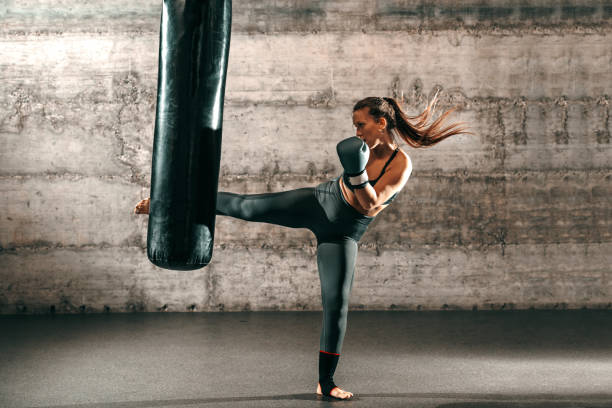You don’t always have time to drive, pack, sweat, wait for machines, or risk overexposure at a gym. Boxing practice at home isn’t a substitute for a gym completely, but for many of us, it’s a lifeline. At home, the barriers fall away. You can just show up, lace up gloves, and train.
I’m Damon. I’m not here to hype you with glam. I’ve boxed, messed up my hands, learned from mistakes. When I say “start small” it’s because I’ve been there. This post is real advice—no fluff.
Doing boxing at home gives you freedom. You can punch shadow-boxing late at night when no one’s watching. You can set your schedule. But to do it well, you need the right mindset and beginner boxing equipment that won’t wreck your wrists. Let’s dig in.
Mindset First: What It Takes to Practice Boxing Solo
You need patience. You will feel awkward early. You might whiff your punches or get winded doing footwork in your living room. That’s normal. Real boxers started that way.
Consistency matters more than volume. Ten minutes today beats one marathon hour once in a while. Build the habit. Even when you don’t feel like it, put the gloves on and do something.
Safety is critical. Never skip warm-ups, stretching, and cooling down. Don’t go full throttle every day. Respect rest and recovery. If you injure a wrist, elbow, or shoulder, you might be sidelined weeks.
Have goals, but small ones. “Improve jab”, “shadow-box 3 rounds”, “learn footwork drills”. Record yourself. Watch. Adjust. This is how you level up.
Space and Setup: Where to Practice Safely at Home
Actually look around your place before you start swinging. You need enough open space. No china, no fragile lamps. Maybe shift a chair, clear a closet door.
Flooring matters. If you have hardwood, you might slide. A rug helps, or better yet, some rubber mats. You don’t need a full gym floor, but grip helps.

Wind currents, windows, ceiling fans—watch them. One mis-punch too close and you’ll shatter a bulb or bruise your knuckle. Keep distance all around.
Mirrors are optional but helpful. If you can mount a full-length mirror or set up one against a wall, watching form is huge in boxing practice at home.
Lighting is underrated. Training in dim light makes your senses dull. Bright light, clean, sharp shadows help you see your muscles, angles, posture.
Beginner Boxing Equipment: What You Actually Need
Alright, here’s the gear list—but don’t go explode your savings. Start minimal, quality over quantity.
Gloves (Boxing Gloves / Sparring Gloves / Training Gloves)
Get good gloves. Don’t skimp. 12oz, 14oz, 16oz depending on your size and weight. Gloves protect your hands, wrists, and gear (like your punch bag). You’ll use them for bag work, pad work, shadow work, sometimes for sparring later.
Go for brands with wrist support. Wraps + gloves = double support.
Hand Wraps
Essential. These are the “invisible armor” for your knuckles, wrists, and small bones. Without wraps, gloves alone won’t save a bad punch. Use 180-inch or 120-inch ones depending on your hands and style. Learn how to wrap well—that’s part of your training.
Punching Bag (Heavy Bag / Free Standing Bag)
If your ceiling can handle it, get a heavy bag and hang it properly (strong beam, reliable hooks). Else choose a free standing bag. Count the bounce, swing, stability, fill. You’ll punch it dozens of times a session. Cheap, wobbly ones drive you mad.
Speed Bag or Double End Bag (Optional but Valuable)
These refine timing, speed, hand-eye coordination. You can add one later. It’s not essential at first, but once you want more challenge, this helps.
Gloves for Sparring (If You Advance)
If you ever get a partner or want to light spar, get sparring gloves (20oz or more). Don’t use your bag gloves—keep gear separate.
Mouthguard / Headgear (If Full Contact)
Even if you’re doing lightly, if you spar, safety gear is nonnegotiable. Mouthguard protects your teeth. Headgear protects the noggin. Use them right.

Jump Rope
Simple, cheap, effective. It’s a cardio weapon. It trains footwork, stamina, rhythm.
Timer / Round Timer
You need a timer. Even your phone works, but boxing-style timers (3 min work, 1 min rest etc.) make life easier.
Floor Mats / Padding
For shadow boxing, mobility drills, ground work (if you do). Cushioned but firm.
Gloves Cleaner / Gear Care
Sweat kills gear. Keep your gloves, wraps, bags dry. Use deodorizers, glove dryers, or simple newspaper.
How to Start a Routine: From Warm-Up to Cool-Down
You need structure. Don’t wander aimless. A solid session has pieces. Here’s a skeleton you can adapt.
Warm up (5–10 min): Jump rope, mobility, joint circles, dynamic stretching. Loosen legs, shoulders, wrists. Get the blood flowing.
Footwork & shadow boxing (5 min): Move, pivot, jab, cross, imagine a target. Focus on balance.
Bag work / drills (3-5 rounds): On the heavy bag, combinations, power, speed.
Technique & skills (2–3 rounds): Focus: only jab, only footwork, pivoting, slipping. Practice defensively.
Conditioning (optional): Burpees, push-ups, core work, or plyo training.
Cool down / stretching (5 min): Stretch arms, shoulders, hips, back. Slow breathing. Reflect.
You don’t always need to train everything. Some days focus on footwork and jab. Other days you go hard on the bag. Vary intensity.
Beginner Boxing Equipment on a Budget: Smart Buying Tips
You don’t need to break your wallet. Here’s how to stretch your rupees.
Buy used (but not broken). If someone sells a heavy bag that’s worn but intact—fine. Inspect seams, fill, chain, mount. But don’t buy torn gloves or broken springs.
Buy from local boxing/fitness stores. You avoid high shipping costs and can test gear. You can even try gloves before buying.
Watch for sales, off-season deals. Brands clear out older models. Get last year’s design—often same quality.
Prioritize safety equipment over fancy extras. Better wraps, better gloves, better hang system first. Skip bells and whistles until core gear is solid.

DIY when possible. Fill a bag with old rags, sandbags, rice sacks. Build a frame. Some people hang heavy bags from beams, joists—but do it securely (or hire someone).
Common Mistakes When Training Boxing at Home
I’ve messed these up myself. Learn from my bruises.
Skipping fundamentals. People jump to power punches without mastering jab, stance, balance. Don’t do that.
Poor hand wrapping. If wraps are loose or wrong, you’ll hurt your wrists. Learn a reliable wrap method.
Punching when tired, sloppy. It’s worthless to throw junk punches fast. Focus on quality. Better slower, precise, than fast and sloppy.
Neglecting defense. Offense is sexy—but defense (head movement, blocking, footwork) saves you. Train slipping, covering.
Overtraining. Your body (especially tendons, joints) needs rest. Do not train full throttle every day. You’ll burn out or get injured.
Ignoring mirror or feedback. You need to see your mistakes. Record video or use mirror. Self-analysis helps.
Sample 8-Week At-Home Progression Plan
Here’s a rough progression structure you can adapt (not a rigid plan, but a framework you can grow with).
- Weeks 1–2: Build habit. Focus on shadow boxing, footwork, light bag work, wrapping properly. Short sessions, 3–4 times per week.
- Weeks 3–4: Increase bag work, combos, some conditioning. Add in jump rope work. Add more rounds (if you can recover).
- Weeks 5–6: Add more technique drills, defense, slipping, feints. Start speed bag or double-end bag if you got it. Increase intensity.
- Weeks 7–8: Mix harder days, lighter days. Start light sparring (if you have protection). Work combination fluency, endurance.
Always keep one “easy” day per week. Deload, focus on mobility and rest.
Safety, Injury Prevention, and Recovery
I can’t stress this enough: training is worthless if you’re injured.
Before sessions, warm up joints: wrists, elbows, shoulders, hips, knees. After sessions, bring down heart rate and stretch.
If you feel sharp pain, stop. Don’t muscle through a tendon injury in your elbow or wrist. Ice, rest, see a physio. Alternate muscle groups. Don’t always hit the heavy bag full power. Mix in technique, shadow, conditioning, and make sure your beginner boxing equipment is appropriate and supportive for your training.
Nutrition, sleep, hydration—they are the unsung coaches. Without recovery your gains will stall.
Massage, foam rolling, soft tissue work help. Do mobility drills off your training days.
Tracking Progress and Adjusting
Don’t guess. Record. Use a journal, app, or video log. Write what you felt, what felt off, what you improved.
Every 2–4 weeks, test yourself: how many good combos can you throw in a minute? How long can you stay active without gasping? Are footwork and agility improving?
When something feels stale, switch it up. New combos, new drills, new equipment. Keep the brain and body engaged.
Find a community (online or local). Share videos, ask for feedback. Even a remote buddy is helpful.
Once your home training is solid, you’ll feel more confident in a gym or class setting. Home becomes your foundation.
Motivation to Keep Going (When It’s Mad Tough)
Some days you’ll hate it. You’ll be sore, tired, unmotivated. You’ll skip sessions. That’s life.
But keep showing up. Remind yourself: you’re doing this for strength, confidence, health, discipline. It’s not about being perfect—it’s about effort.
Change is slow. If you feel like you’re not improving, go back to basics. Reset, refine technique. Incremental gains stack.
Treat failure as data, not shame. Missed session? Don’t drop the ball entirely. Do a light session tomorrow. Show yourself consistency.
Celebrate small wins: a better jab, tighter wrap, clearer footwork, less winded breathing. Recognize them.
What to Do When You Want to Advance Beyond Beginner Stage
Once you feel stable with your basics, it’s time to add complexity.
Get a coach or join a local gym occasionally to get live feedback. Home can only take you so far without external eyes.
Add sparring (carefully, slowly). Start light, increase intensity over time. Use sparring gloves, mouthguard, headgear. Do not rush.
Add advanced equipment: double-end bags, angled bags, reaction balls, resistance bands, mitts. These challenge your reflexes, precision, speed.
Incorporate strength training, weighted calisthenics, plyometrics. Boxing is not just punching—it’s explosive core, legs, conditioning.
Record pro boxers, learn footwork and combinations. Steal what works, adapt to your style.
Never stop refining basics. As you get more advanced, the fundamentals become more important, not less.
FAQs: Boxing Practice at Home & Beginner Boxing Equipment
Q: Can I do effective boxing practice at home without a heavy bag?
Yes—you can use shadow boxing, footwork drills, shadow with resistance bands, use pillow or makeshift pads. But a heavy bag adds resistance, impact training, and more realistic feedback.
Q: What weight gloves should a beginner choose?
Beginners generally use 12oz to 16oz gloves depending on body weight. Heavier gloves give more protection but slow you a bit. Always combine with good hand wraps.
Q: Is a free standing bag good enough?
Yes, for many home setups. It’s safer if you can’t hang from ceiling beams. But free standing bags bounce more and may move. Ensure stability and fill.
Q: How often should a beginner train boxing at home?
Start with 3–4 times per week. You need rest days. Over time, you can add 5 days. Listen to your body.
Q: How long are effective sessions?
30 to 60 minutes is plenty—especially early on. Focus on quality, not length.